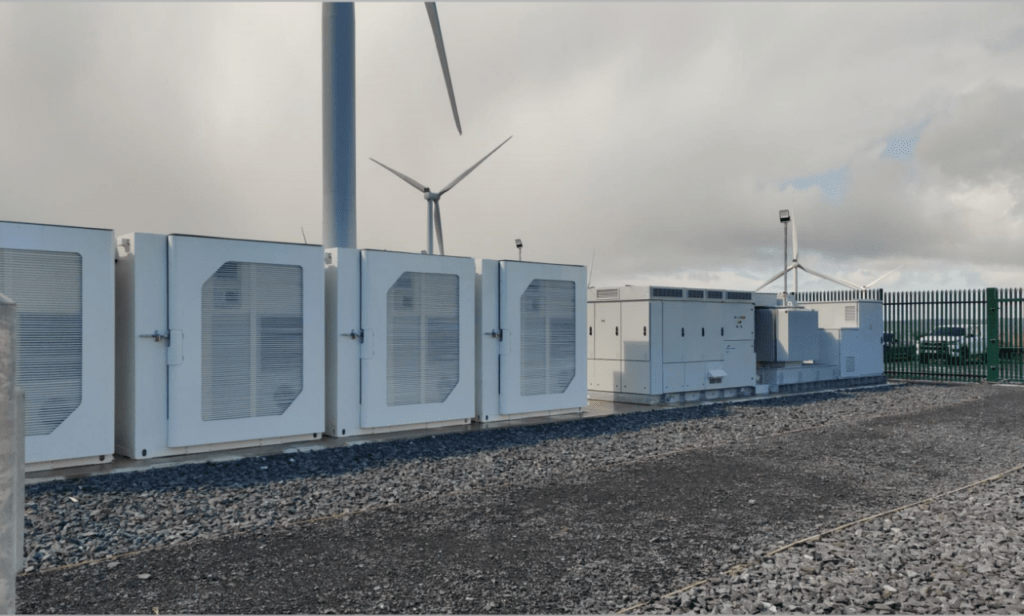The ribbon-cutting event at the Arlington Microgrid, Washington state. Image: Snohomish PUD.
Microgrid projects in the US states of Washington and Maryland combining battery storage, solar and vehicle-grid integration have gone online.
Arlington Microgrid in Washington
Snohomish County PUD, a utility serving customers in Snohomish County and Camano Island, cut the ribbon on the Arlington Microgrid and Clean Energy Center last week (25 October), near Arlington Airport.
The project combines a 500kW solar PV array and a 1MW/1.4MWh lithium-ion battery energy storage system (BESS) and a pair of vehicle-to-grid (V2G) charging stations. The BESS is a PowerStore unit provided by Hitachi Energy, a wholly-owned subsidiary of the Japanese conglomerate Hitachi, formerly called Hitachi ABB Power Grids. Mitsubishi Electric provided the V2G charging infrastructure.
The project is focusing on combining the resources for disaster recovery, grid resiliency and electric vehicle integration. Specifically, it will go into islanding mode and provide power to the PUD’s Arlington Community Office during a grid outage (such as one caused by a wind storm or earthquake), a facility with a peak load of 150kW.
The PUD said that the project will demonstrate multiple uses of energy storage, provide a plan and design to study for future microgrid projects, and increase grid reliability in case of an emergency. The University of Washington will provide modelling, data analysis and reports on the project until 2033.
“The Arlington Microgrid provides a foundation for meeting both today’s emerging energy challenges and the future energy needs in Washington state and beyond,” said Antonio Verga, Hitachi Energy general manager of Grid Edge Solutions.
The utility purchased two Nissan Leaf EVs for the V2G part of the project. The Leaf is the only widely used consumer EV in the US market which is bidirectionally-capable.
The solar portion of the project is part of a community solar programme, and the PUD said that 500-plus of its customers reserved 100% of its available units in under a month, while 10% of the units were granted to two community service providers to benefit low-income households.
As shown in a design of the project below, it will connect to a Clean Energy Center which will host the microgrid controller and demonstrate the technology to help educate the public about new energy technologies. A solar PV tree is also on-site. The Center has a peak load of 50kW, highest on winter days due to heating requirements.
The PUD received US$3.5 million in funding from the Department of Commerce’s Clean Energy Fund to complete the project, which cost a total of US$12 million.
Image: Snohomish County PUD.
Pacific Northwest National Laboratory (PNNL) produced two reports assessing the lifetime cost-benefit of the V2G aspect of the microgrid. It looked at various factors which influence the economics of the technology, including battery cell degradation, replacement, roundtrip efficiencies, wholesale andretail energy prices.
A PUD report said the PNNL’s study results indicated a strong correlation between the number of battery charge/discharge cycles and the cost of V2G.
The project also includes a 350kW backup diesel generator for when the BESS and solar array can no longer provide the islanding capabilities alone.
John Haarlow, PUD CEO/general manager, said: “Battery energy storage will help make critical infrastructure impervious to outages and help us meet energy demand when customer usage is at its highest. Vehicle-to-grid charging will allow us to work with homeowners and business owners to leverage EVs as backup or grid-assisted power sources.”
Read the University of Washington’s Techno-Economic Analysis of the Arlington Microgrid from February 2022 here.
Brookville Smart Energy Bus Depot in Maryland
In similar news, an EV charging station with a solar PV array, on-site BESS and microgrid controller allowing islanding mode was announced as operational yesterday (31 October).
The Brookville Smart Energy Bus Depot in Brookville, Maryland, will eventually power 70 electric buses belonging to the Brookville transit bus fleet, with 4.14MW of charging capacity.
It features a 3MW/4.3MWh energy storage system (ESS) from Dynapower which will store power to charge the electric buses during a grid outage, thus enabling the migrogrid capability. It also will also allow the Depot to participate in local utility Potomac Electric Power Company’s (Pepco) demand response programme.
How soon it will be charging 70 electric buses is not clear. 70 buses equates to half of the town’s bus fleet and Maryland as a state has a goal of 50% emissions-free buses by 2030.
A 1.6MW PV array and 1.9MW of diesel generators comprise the remaining power sources for the 6.5MW project.
Germany-headquartered firm The Mobility House is providing its ChargePilot software to optimise scheduling and the charging of the buses. The system coordinates with the charging capacity to source onsite power at the correct times throughout the day while ensuring that EV charging responds to load balancing and peak shaving commands from the microgrid controller.
Press releases from The Mobility House and Dynapower did not, however, go as far as saying that the microgrid will use vehicle-to-grid technology. Electrified buses hold a lot of potential for V2G technology thanks to larger battery sizes, more predictable schedules and a more consolidated pool of customers than the consumer EV space.
Public transit is a bit further behind when it comes to V2G participation than school buses. This is because they are out on the road a lot more and there are fewer bidirectionally-capable electric transit bus models. But, battery sizes typically 1.5-2 times bigger than a school bus and larger fleet sizes mean they also have significant potential as grid assets in the long run.
Continue reading










